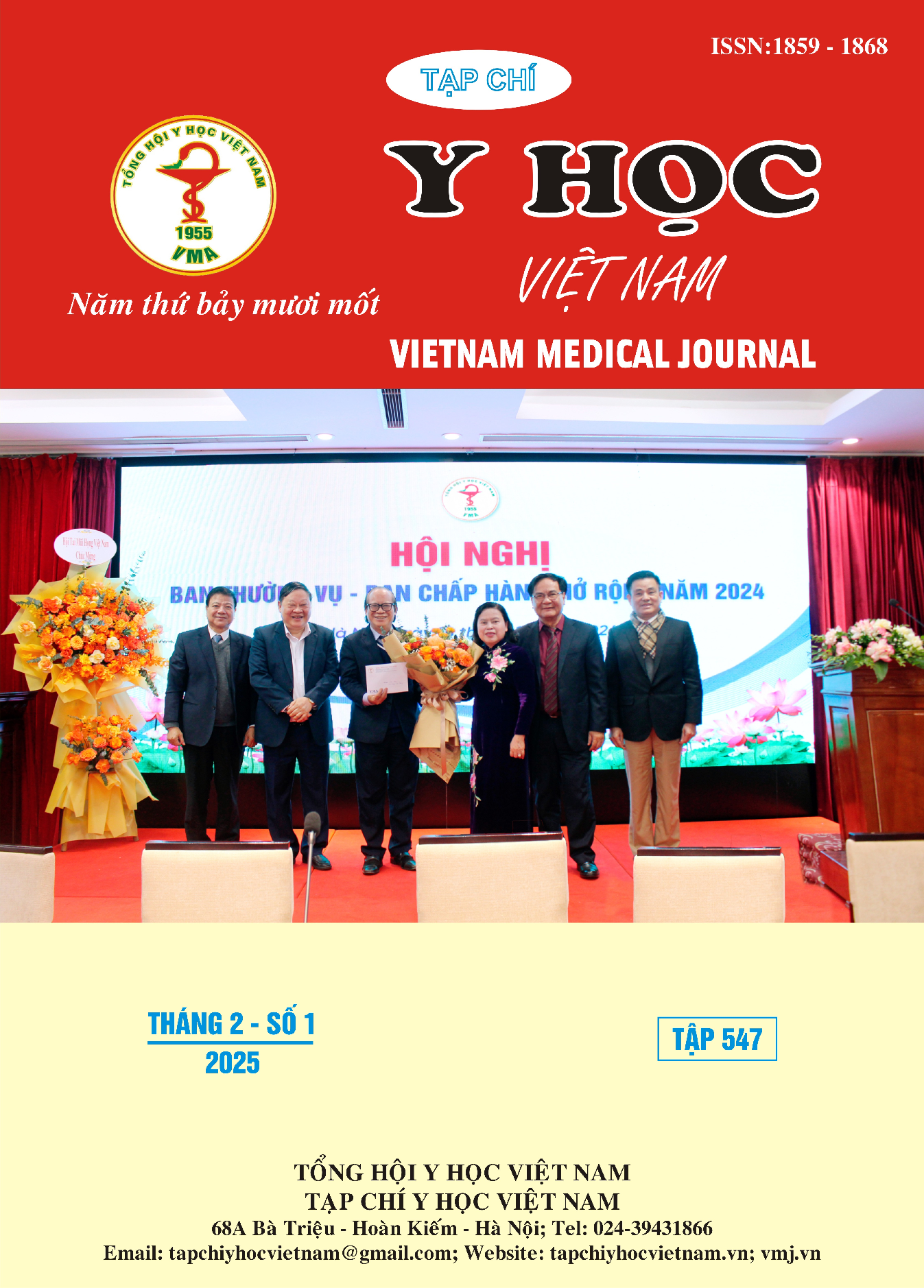STUDY OF COMPUTED TOMOGRAPHY CHARACTERISTICS OF RUPTURED ABDOMINAL AORTIC ANEURYSM
Main Article Content
Abstract
Introduction: Ruptured abdominal aortic aneurysm (RAAA) is a surgical emergency condition with a high mortality rate, so rapid and accurate diagnosis is extremely important. Currently, computed tomography (CT) is the primary tool for assessing RAAA due to its ability to provide quick and easy evaluation with high accuracy and it is widely used in clinical practice. Objective: To describe the characteristic features of RAAA on computed tomography and identify the diagnostic value of these imaging characteristics for RAAA. Methods: A cross-sectional study was conducted, describing and analyzing data from 69 patients suspected of abdominal aortic aneurysm rupture who underwent computed tomography and surgery at Cho Ray Hospital from January 2019 to June 2023. The characteristics from these CT scans were calculated as percentages, p-values, sensitivity, specificity and AUC in differentiating between abdominal aortic aneurysm rupture and non-rupture cases. Results: The study included 48 patients with RAAA and 21 patients with non-RAAA. We observed eight significant imaging features in distinguishing RAAA from non-RAAA. Among these, the maximum horizontal dimension (82.1 ± 25.5 mm vs 63.9 ± 11 mm, p = 0.002), thickness mural thrombus (19.5 ± 10.1 mm vs 15.7 ± 5.5 mm, p=0.049), intra- or retroperitoneal hematoma was the highest sensitivity feature at 97.9%. The characteristics of focal wall discontinuity and contrast extravasation both demonstrated the highest specificity at 100%. The characteristics of hyperattenuating crescent sign and draped aorta sign had low sensitivity at 52.1% but high specificity, exceeding 80% at 90.5% and 81%, respectively. Heterogeneous thrombus attenuation was indicative of non-RAAA. Conclusion: The maximum horizontal diameter and mural thrombus thickness were higher in patients with RAAA compared to patients without RAAA and were statistically significant. Intra- or retroperitoneal hematoma was the single most valuable feature in diagnosing RAAA. The features of focal wall discontinuity and contrast extravasation both had the highest specificity. The features of hyperattenuating crescent sign and draped aorta sign had low sensitivity but high specificity in diagnosing RAAA. Heterogeneous thrombus attenuation was a feature suggestive of non-RAAA.
Article Details
Keywords
Rupture of abdominal aortic aneurysm, computed tomography.
References
2. Warner CJ, Roddy SP, Chang BB, et al. Regionalization of Emergent Vascular Surgery for Patients With Ruptured AAA Improves Outcomes. 2016; 264(3): 538-543. doi:10.1097/sla. 0000000000001864
3. Lech C, Swaminathan A. Abdominal Aortic Emergencies. Emergency Medicine Clinics of North America. 2017/11/01/ 2017;35(4):847-867. doi:https://doi.org/10.1016/j.emc.2017.07.003
4. Donaldson MC, Rosenberg JM, Bucknam CA. Factors affecting survival after ruptured abdominal aortic aneurysm. Journal of vascular surgery. Jul 1985;2(4):564-70.
5. Buijs RVC, Willems TP, Tio RA, et al. Current state of experimental imaging modalities for risk assessment of abdominal aortic aneurysm. Journal of vascular surgery. 2013/03/01/ 2013;57(3):851-859. doi:https://doi.org/10.1016/ j.jvs.2012.10.097
6. Fernando SM, Tran A, Cheng W, et al. Accuracy of presenting symptoms, physical examination, and imaging for diagnosis of ruptured abdominal aortic aneurysm: Systematic review and meta-analysis. Academic Emergency Medicine. 2022/04/01 2022;29(4):486-496. doi:https://doi.org/10.1111/acem.14475
7. Lloyd GM, Bown MJ, Norwood MGA, et al. Feasibility of preoperative computer tomography in patients with ruptured abdominal aortic aneurysm: a time-to-death study in patients without operation. Journal of vascular surgery. 2004; 39(4): 788-791. doi:10.1016/j.jvs.2003. 11.041
8. Biancari F, Paone R, Venermo M, D'Andrea V, Perälä J. Diagnostic Accuracy of Computed Tomography in Patients with Suspected Abdominal Aortic Aneurysm Rupture. European Journal of Vascular and Endovascular Surgery. 2013; 45(3): 227-230. doi:10.1016/j.ejvs.2012. 12.006
9. Liu H, Chen Z, Tang C, et al. High-density thrombus and maximum transverse diameter on multi-spiral computed tomography angiography combine to predict abdominal aortic aneurysm rupture. Original Research. 2022-September-30 2022;9doi:10.3389/fcvm.2022.951264
10. Lindeman JH, Matsumura JS. Pharmacologic Management of Aneurysms. Circulation research. 2019/02// 2019;124(4):631-646. doi:10.1161/ circresaha.118.312439


